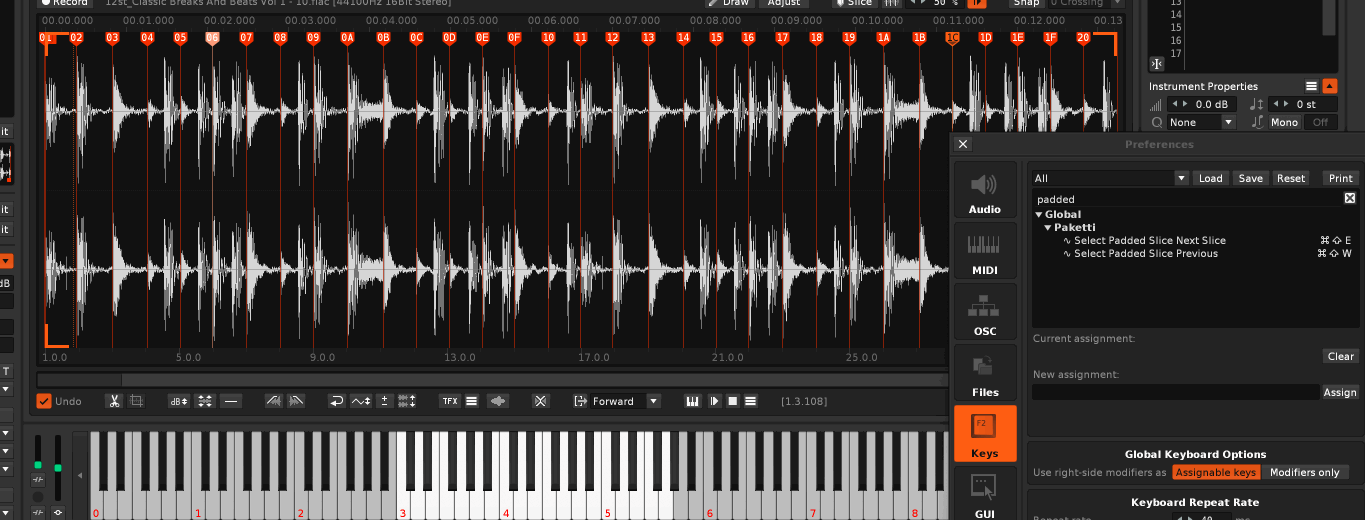ok i’m ready to ask for advice and show what i’m working with…
the issue is that when i reverse direction (instead of going nextSlice, i go prevSlice) - the first time the shortcut is run, it displays the exact same slice. and if i go from prevSlice to nextSlice - the first run displays the exact same slice.
how do i solve this logic? since on nextSlice, the preferences.sliceCounter.value is increased by +1, and by prevSlice, the preferences.sliceCounter.value is increased by -1, i need it to be able to detect, “previous movement was next” == if running prevSlice, act as if sliceCounter actually provided -1 (i.e. nextSlice set it to 4, prevSlice should start as if it’s 3.) or prevSlice set it to 2, and nextSlice should then be 3.
apart from this logic issue, the script works beautifully.
-- Function to select the next slice
function selectNextSliceInOriginalSample()
local instrument = renoise.song().selected_instrument
local sample = instrument.samples[renoise.song().selected_sample_index]
local sliceMarkers = sample.slice_markers
local sampleLength = sample.sample_buffer.number_of_frames
if #sliceMarkers < 2 or not sample.sample_buffer.has_sample_data then
renoise.app():show_status("Not enough slice markers or sample data is unavailable.")
return
end
local currentSliceIndex = preferences.sliceCounter.value
local nextSliceIndex = currentSliceIndex + 1
if nextSliceIndex > #sliceMarkers then
nextSliceIndex = 1
end
local thisSlice = sliceMarkers[currentSliceIndex]
local nextSlice = sliceMarkers[nextSliceIndex]
local thisSlicePadding = (currentSliceIndex == 1 and thisSlice < 1000) and thisSlice or math.max(thisSlice - 1000, 1)
local nextSlicePadding = (nextSliceIndex == 1) and math.min(nextSlice + sampleLength, sampleLength) or math.min(nextSlice + 1354, sampleLength)
renoise.app().window.active_middle_frame = renoise.ApplicationWindow.MIDDLE_FRAME_INSTRUMENT_SAMPLE_EDITOR
sample.sample_buffer.display_range = {thisSlicePadding, nextSlicePadding}
sample.sample_buffer.display_length = nextSlicePadding - thisSlicePadding
renoise.app():show_status(string.format("Slice Info - Current index: %d, Next index: %d, Slice Start: %d, Slice End: %d", currentSliceIndex, nextSliceIndex, thisSlicePadding, nextSlicePadding))
preferences.sliceCounter.value = nextSliceIndex
end
-- Function to select the previous slice with proper handling of slice wrapping
function selectPreviousSliceInOriginalSample()
local instrument = renoise.song().selected_instrument
local sample = instrument.samples[renoise.song().selected_sample_index]
local sliceMarkers = sample.slice_markers
local sampleLength = sample.sample_buffer.number_of_frames
if #sliceMarkers < 2 or not sample.sample_buffer.has_sample_data then
renoise.app():show_status("Not enough slice markers or sample data is unavailable.")
return
end
local currentSliceIndex = preferences.sliceCounter.value
local previousSliceIndex = currentSliceIndex - 1
if previousSliceIndex < 1 then
previousSliceIndex = #sliceMarkers -- Wrap to the last slice
end
local previousSlice = sliceMarkers[previousSliceIndex]
local nextSliceIndex = previousSliceIndex == #sliceMarkers and 1 or previousSliceIndex + 1
local nextSlice = sliceMarkers[nextSliceIndex]
-- Calculate the padding for display
local previousSlicePadding = math.max(previousSlice - 1000, 1)
local nextSlicePadding = math.min(nextSlice + 1354, sampleLength)
-- Adjust for wraparound display issue when navigating from first to last slice
if previousSliceIndex == #sliceMarkers and currentSliceIndex == 1 then
nextSlicePadding = sampleLength
end
-- Set display parameters in the sample editor
renoise.app().window.active_middle_frame = renoise.ApplicationWindow.MIDDLE_FRAME_INSTRUMENT_SAMPLE_EDITOR
sample.sample_buffer.display_range = {previousSlicePadding, nextSlicePadding}
sample.sample_buffer.display_length = nextSlicePadding - previousSlicePadding
-- Show status and update slice counter
renoise.app():show_status(string.format("Slice Info - Previous index: %d, Current index: %d, Slice Start: %d, Slice End: %d",
previousSliceIndex, nextSliceIndex, previousSlicePadding, nextSlicePadding))
preferences.sliceCounter.value = previousSliceIndex
end
-- Function to reset the slice counter
function resetSliceCounter()
preferences.sliceCounter.value = 1
renoise.app():show_status("Slice counter reset to 1. Will start from the first slice.")
selectNextSliceInOriginalSample()
end
-- Keybindings
renoise.tool():add_keybinding{name="Global:Paketti:Select Padded Slice Next Slice", invoke=selectNextSliceInOriginalSample}
renoise.tool():add_keybinding{name="Global:Paketti:Select Padded Slice Previous", invoke=function() selectPreviousSliceInOriginalSample() end}
renoise.tool():add_keybinding{name="Global:Paketti:Reset Slice Counter", invoke=resetSliceCounter}

i tried a preferences.slicePreviousDirection and setting it to “0” for “previous” and “1” for “next”. but i couldn’t figure out the logic. please help?
p.s. if anyone is wondering what this is, it lets you trim and tweak the slicings so that they hit where they’re supposed to.
and while i like the idea for my own use, there was a request for it from 2022 - and maybe some other years too. Mappable shortcuts to navigate through slice markers (i’m yet to finish going through all the 7300+ ideas and suggestions i’ve archived as PDF per thread, i think i’ve gone through 300 right now.
